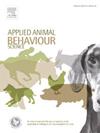Behavior and safety in the use of canopy bridges by howler monkeys in an experimental environment
IF 2.2
2区 农林科学
Q1 AGRICULTURE, DAIRY & ANIMAL SCIENCE
引用次数: 0
Abstract
Urban sprawl advances over forested areas and threatens arboreal species, which often use roads, power lines, and rooftops to move, resulting in roadkill, electrocution, and dog attacks. One measure to mitigate these risks is the installation of canopy bridges, which connect vegetation fragments and provide safe passages for animals. This study evaluated the use of three canopy bridge designs by brown howler monkeys (Alouatta guariba) and black-and-gold howler monkeys (Alouatta caraya) in captivity at the Sapucaia do Sul Zoo. The designs included a ladder rope bridge with PVC pipes, a fire hose bridge, and a braided rope bridge. We recorded primate behavior in relation to the canopy bridges using scan sampling, focal sampling, and ad libitum observations. After 30 days of observation, 270 hours of primate behavior were recorded, with 8.58 % of these behaviors related to bridge use, totaling 476 complete crossings. The analysis revealed that howler monkeys used the bridges primarily for locomotion and play. The type of activity was associated with bridge design for brown howler monkeys, as they used the ladder bridge more for feeding and the fire hose bridge for resting. In contrast, black-and-gold howler monkeys did not exhibit such an association but preferred the braided rope bridge and the fire hose bridge. Both species demonstrated good adaptation to the bridges, using a quadrupedal posture for locomotion, maintaining a good balance and making few missteps. Crossing time did not vary much between bridge designs for either species, but there was a trend of increasing speed over time. Our results indicate that all bridge designs were used by howler monkeys, demonstrating good adaptation and safety. The bridges proved to be valuable tools for both environmental enrichment and facilitating howler monkey locomotion in captivity.
实验环境下吼猴使用树冠桥的行为与安全
城市扩张蔓延到森林地区,威胁到树木物种,这些物种经常使用道路,电力线和屋顶移动,导致道路死亡,触电和狗袭击。减轻这些风险的一项措施是安装树冠桥,连接植被碎片,为动物提供安全通道。本研究评估了三种树冠桥设计在Sapucaia do Sul动物园的棕色吼猴(Alouatta guariba)和黑金吼猴(Alouatta caraya)的使用。这些设计包括一个带有PVC管的梯子绳桥、一个消防水带桥和一个编织绳桥。我们使用扫描取样、焦点取样和随意取样的方法记录了灵长类动物在树冠桥上的行为。经过30天的观察,共记录了270 小时的灵长类动物行为,其中8.58 %的行为与过桥有关,共完成过桥476次。分析显示,吼猴主要利用桥来移动和玩耍。这种活动类型与棕色吼猴的桥梁设计有关,因为它们更多地使用梯子桥来进食,而使用消防水管桥来休息。相比之下,黑金吼猴没有表现出这种联系,而是更喜欢编织绳桥和消防水管桥。这两个物种都表现出了对桥梁的良好适应,它们用四足行走,保持良好的平衡,很少失足。两种桥梁设计的穿越时间差异不大,但随着时间的推移,速度有增加的趋势。结果表明,所有桥梁设计都被吼猴使用,具有良好的适应性和安全性。这些桥被证明是有价值的工具,既丰富了环境,又促进了圈养吼猴的运动。
本文章由计算机程序翻译,如有差异,请以英文原文为准。
求助全文
约1分钟内获得全文
求助全文
来源期刊

Applied Animal Behaviour Science
农林科学-行为科学
CiteScore
4.40
自引率
21.70%
发文量
191
审稿时长
18.1 weeks
期刊介绍:
This journal publishes relevant information on the behaviour of domesticated and utilized animals.
Topics covered include:
-Behaviour of farm, zoo and laboratory animals in relation to animal management and welfare
-Behaviour of companion animals in relation to behavioural problems, for example, in relation to the training of dogs for different purposes, in relation to behavioural problems
-Studies of the behaviour of wild animals when these studies are relevant from an applied perspective, for example in relation to wildlife management, pest management or nature conservation
-Methodological studies within relevant fields
The principal subjects are farm, companion and laboratory animals, including, of course, poultry. The journal also deals with the following animal subjects:
-Those involved in any farming system, e.g. deer, rabbits and fur-bearing animals
-Those in ANY form of confinement, e.g. zoos, safari parks and other forms of display
-Feral animals, and any animal species which impinge on farming operations, e.g. as causes of loss or damage
-Species used for hunting, recreation etc. may also be considered as acceptable subjects in some instances
-Laboratory animals, if the material relates to their behavioural requirements
 求助内容:
求助内容: 应助结果提醒方式:
应助结果提醒方式:


